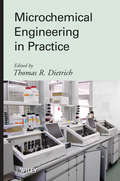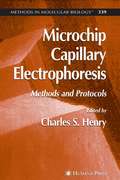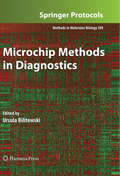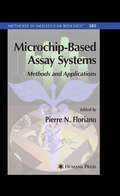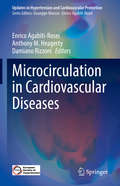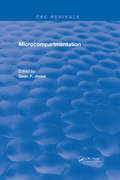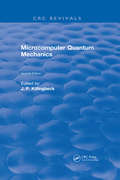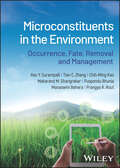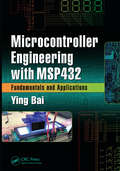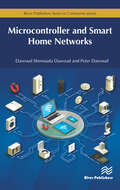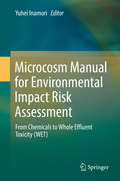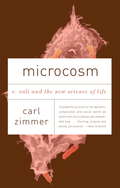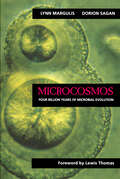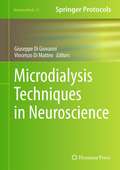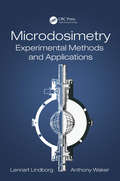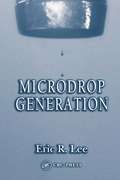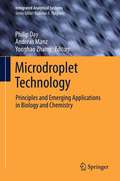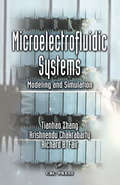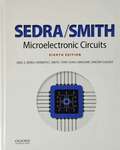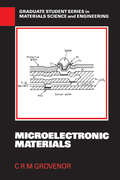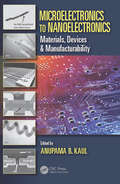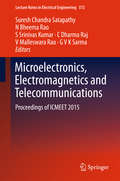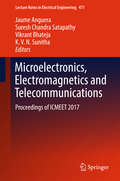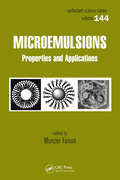- Table View
- List View
Microchemical Engineering in Practice
by Thomas DietrichMicrochemical Engineering in Practice provides the information chemists and engineers need to evaluate the use of microreactors, covering the technical, operational, and economic considerations for various applications. It explains the systems needed to use microreactors in production and presents examples of microreactor use in different chemistries, including larger scale production processes. There are guidelines on calculating the costs and the risks of production using continuous flow microreactors. Complete with case studies, this is an essential guide for chemists and engineers interested in investigating the advantages of chemical microreactors.
Microchip Capillary Electrophoresis
by Charles HenryLeading chemists and engineers concisely explain the principles behind microchip capillary electrophoresis and demonstrate its use in a variety of biochemical applications, ranging from the analysis of DNA, proteins, and peptides to single cell analysis and measuring the impact of surface modification on flow in microfluidic channels. Since surface chemistry must be carefully considered for optimal operation at this scale, the authors also discuss methods of both adsorbed and covalent surface modification for its control. Fabrication methods for producing microchips with glass, poly(dimethylsiloxane), and other polymers are also provided so that even novices can produce simple devices for standard separations. Microchip Capillary Electrophoresis: Methods and Protocols provides a practical starting point for either initiating research in the field of microchip capillary electrophoresis or understanding the full range of what can be done with existing systems.
Microchip Methods in Diagnostics
by Ursula BilitewskiIn this new age of science and technology, microchip methods of analysis have developed into an essential tool for biomedical researchers. Microchip Methods in Diagnostics looks at this increasingly miniaturized technology, focusing on DNA microarrays, protein microarrays, and labs-on-chips, and supporting the introduction of new diagnostic methods based on microtechnologies. The work provides a background on the technological aspects of each of these methods, followed by chapters describing the methods with regard to specific applications. Since it uses only those processes which have reached a certain level of maturation, this volume is able to provide approaches that are applicable in practice even by the non-expert. Composed in the highly successful Methods in Molecular Biology series format, each chapter contains a brief introduction, step-by-step methods, a list of necessary materials, and a Notes section which shares tips on troubleshooting and avoiding known pitfalls. An innovative and cutting-edge work, Microchip Methods in Diagnostics strives to bring the technology of microchips even further into the world of diagnostics, predicting incredible benefits for patients in the years to come.
Microchip-Based Assay Systems
by Pierre N. FlorianoThis cutting-edge book explores recent progress in the microelectronics arena. It examines the resultant miniaturization of component device features to nanometer size particles, and the ensuing growth in the development and use of microchip-based techniques in leading laboratories around the world. In the sixteen chapters of this volume, leading scientists present technically precise microchip-based assays for a variety of applications.
Microcirculation in Cardiovascular Diseases (Updates in Hypertension and Cardiovascular Protection)
by Anthony M. Heagerty Enrico Agabiti-Rosei Damiano RizzoniThis book offers an extensive review of the most recent data on the pathophysiological role of structural and functional alterations in the microcirculation, particularly focusing on hypertension and diabetes. It covers several relevant and innovative aspects, including the possible mechanisms involved in the development of microvascular remodeling and rarefaction, the technical approaches available for the detection of microvascular alterations, including non-invasive evaluations, the prognostic role of changes in small resistance artery structure, the possibility of preventing or regressing such alterations with appropriate treatment, and the potential clinical advantages of such intervention. A number of innovative areas of research are considered, including the role of the immune system, inflammation and oxidative stress in the development of microvascular alterations. Lastly, it examines the availability of recent non-invasive methods for the evaluation of small resistance artery morphology in the retina, which in the near future may provide a useful tool for the stratification of cardiovascular risk and even for clinical decisions regarding drug treatment, thus providing physicians with a clinically relevant instrument for improving and optimizing the management of hypertensive and diabetic patients. The book provides valuable, clinically relevant information for specialists (cardiology, internal medicine, and endocrinology) and general practitioners, and also offers novel and stimulating data to basic and clinical researchers.
Microclimate and Local Climate
by Roger G. Barry Barry, Roger G. and Blanken, Peter D. Peter D. BlankenThis book provides an up-to-date, comprehensive treatment of the variables and processes of microclimate and local climate, including radiation balance and energy balance. It describes and explains the climate within the lower atmosphere and upper soil, the region critical to life on Earth. Topics that are covered include not only the physical processes that affect microclimate, but also biological processes that affect vegetation and animals, including people. A geographic tour of the microclimates of the major ecosystems around the world is included. All major biomes and surface types, including urban areas, are examined, and the effects of climate change on microclimate are described. This book is invaluable for advanced students and researchers in climatology in departments of environmental science, geography, meteorology, agricultural science, and forestry.
Microcompartmentation
by D.P. JonesMicrocompartmentation refers to nonhomogeneous distribution of solutes in compartments of cells or associated structures without intervening membranal barriers. Such variations in concentration of ions, metabolites, intracellular messengers, and nutrients can introduce significant heterogeneity in subcellular function and regulation. The current focus on biological examples of microcompartmentation provides ample evidence for its importance and the role of physical structure in determining local chemical environments. The examples present in the different chapters include microcompartmentation of Ca2+,H+,ATP. ADP, O2, glycolytic intermediates, fatty acids, amino acids, and nucleic acid precursors. In reviewing these systems, the authors provide a useful resource for experimental approaches to study microcompartmentation and provide the basis for future studies of its role in regulation of cell functions.
Microcomputer Quantum Mechanics
by J P KillingbeckMicrocomputer Quantum Mechanics combines the teaching of computing skills with depth of mathematical understanding. This practical text demonstrates how computation can be integrated with theoretical analysis as part of a unified attack on problems in one of the most interesting areas of modern physics. The author discusses the mathematical principles behind the programs and actually creates new methods to facilitate the application of microcomputers in quantum mechanics.Microcomputer Quantum Mechanics combines the teaching of computing skills with depth of mathematical understanding. This practical text demonstrates how computation can be integrated with theoretical analysis as part of a unified attack on problems in one of the most interesting areas of modern physics. The author discusses the mathematical principles behind the programs and actually creates new methods to facilitate the application of microcomputers in quantum mechanics.
Microconstituents in the Environment: Occurrence, Fate, Removal and Management
by Rao Y. Surampalli Tian C. Zhang Makarand M. Ghangrekar Chih-Ming Kao Puspendu Bhunia Manaswini Behera Prangya R. RoutMicroconstituents in the Environment Comprehensive introduction to managing novel pollutants commonly released into the environment through industrial and everyday processes Microconstituents in the Environment: Occurrence, Fate, Removal and Management provides the readers with an understanding of the occurrence and fate of microconstituents, pollutants that have not previously been detected or regulated under current environmental laws or may cause known or suspected adverse ecological and/or human health effects even at insignificant levels, covering their presence in the environment and possible management strategies. The text is practice-oriented and evaluates a wide range of technologies for pollutant removal and how to implement them in the field. In Microconstituents in the Environment, readers will find information on: Fundamental ideas regarding microconstituents, including their classification, major sources, and detection methods, and their removal via biological treatment techniques Fate and transport of microconstituents in various environmental domains, including mathematical modeling based on remote sensing techniques Physicochemical treatment techniques for microconstituents, including precipitation, absorption, filtration, membrane separation, and oxidation Sustainability and environmental management, including the regulatory framework and requirements for developing a new field application, plus an outlook on green design concepts With its emphasis on management and remediation, Microconstituents in the Environment is a highly useful one-stop resource on the subject for environmental scientists, modelers, government agencies, and research scientists working in the field of environmental pollution.
Microcontroller Engineering with MSP432: Fundamentals and Applications
by Ying BaiThis book aims to develop professional and practical microcontroller applications in the ARM-MDK environment with Texas Instruments MSP432P401R LaunchPad kits. It introduces ARM Cortex-M4 MCU by highlighting the most important elements, including: registers, pipelines, memory, and I/O ports. With the updated MSP432P401R Evaluation Board (EVB), MSP-EXP432P401R, this MCU provides various control functions with multiple peripherals to enable users to develop and build various modern control projects with rich control strategies. Micro-controller programming is approached with basic and straightforward programming codes to reduce learning curves, and furthermore to enable students to build embedded applications in more efficient and interesting ways. For authentic examples, 37 Class programming projects are built into the book that use MSP432P401R MCU. Additionally, approximately 40 Lab programming projects with MSP432P401R MCU are included to be assigned as homework.
Microcontroller and Smart Home Networks (River Publishers Series In Communications Ser.)
by Dawoud Shenouda Dawoud Peter DawoudOver recent years industries have faced the problem of how to connect devices to ‘speak’ to each other with minimum wiring. Philips Semiconductors faced this problem when they needed to connect many ICs together. The Automotive Industry faced the same problem when it needed to connect tens of microcontrollers in each car. Recently, with smart homes, the problem has started to be part of each home. For instance, you may want to build your smart home with accessories from different manufacturers and you want the devices to ‘speak’ to each other. Added to that, you may want to control them from a central App or voice assist.Solutions for this problem started with the introduction of Inter Integrated Circuits (IIC) and Controller Area Networks (CAN). Both solutions are wired networks that allow ICs and microcontrollers to be connected in a network to communicate together.In smart home automation, a number of common smart home automation protocols that allow different devices to speak and communicate together have appeared during the last few decades. Some of the smart home protocols come under the umbrella of what is called the “Internet of Things (IoT)”. The proposed protocols can be grouped into wired networks e.g. X10, UPB; wireless or radio networks as ZigBee, Z-Wave, Bluetooth; or dual (wired and radio) such as Insteon.This book introduces to the reader some of the most popular Microcontroller and Smart home networks. The book covers in detail the following protocols:• I2C• I3C• CAN• ZigBee• ZigBee Pro• Z-Wave• BluetoothWi-Fi, WiMax and Insteon are part of our companion book “Serial Communication Protocols and Standards”.This book gives detailed comparisons between the various protocols. To complete the knowledge of the reader, the book gives in the last chapter a short summary on the protocols that we did not fully cover in this volume: Ethernet, Thread, Insteon, X10 and UPB.
Microcosm Manual for Environmental Impact Risk Assessment: From Chemicals to Whole Effluent Toxicity (WET)
by Yuhei InamoriThis book offers a comprehensive guide to microcosms (N-systems) in multiple-species testing and aquatic ecosystem risk assessment. It provides standardized methods for creating the microbial ecosystem, and proposes a standardized microcosm system for environmental impact risk assessments. The book will be of interest to students and educators, researchers, government authorities, developers and manufacturers engaged in ecosystem preservation, water quality management personnel at sewage treatment or industrial effluent treatment facilities, and anyone involved in education, management and analysis evaluation for environmental standards and waste water quality standards.
Microcosm: E. coli and the New Science of Life
by Carl ZimmerThe bacteria E. coli is perhaps most popularly recognized as an agent of human disease, but in fact most forms of E. coli are harmless and, even more significantly for the purposes of Zimmer (a science writer for The New York Times), the bacteria has been the subject of sustained study by scientists for over 100 years, making it an ideal window into the history of life. He gives the general reader a tour of the science of E. coli, describing its lessons for the nature of life, processes of evolution, and even modern genetic engineering. Annotation ©2008 Book News, Inc., Portland, OR (booknews.com)
Microcosmos: Four Billion Years of Microbial Evolution
by Lynn Margulis Dorion Sagan"Microcosmos is nothing less than the saga of the life of the planet. Lynn Margulis and Dorion Sagan have put it all together, literally, in this extraordinary book, which is unlike any treatment of evolution for a general readership that I have encountered before. A fascinating account that we humans should be studying now for clues to our own survival."—From the Foreword by Dr. Lewis ThomasMicrocosmos brings together the remarkable discoveries of microbiology in the later decades of the 20th century and the pioneering research of Dr. Margulis to create a vivid new picture of the world that is crucial to our understanding of the future of the planet. Addressed to general readers, the book provides a beautifully written view of evolution as a process based on interdependency and their interconnectedness of all life on the planet.
Microdialysis Techniques in Neuroscience
by Vincenzo Di Matteo Giuseppe Di GiovanniSince its first application, microdialysis has become incredibly popular to study brain function and has been applied with success in different fields from psychopharmacology, neurobiology, and physiology in animals and also humans. Microdialysis Techniques in Neuroscience focuses on the practical aspects of microdialysis in animal and human, highlighting current technical limitations and providing a vision of what is yet to come for the determination of the most disparate compounds in the brain. The book's contents range from new techniques for detection and quantifying the release of several different neurotransmitters in vitro and in vivo, even in freely moving animals, to sophisticated use of reverse dialysis and the application of microdialysis in pharmacokinetic studies. Each of the sixteen chapters, in fitting with the spirit of the Neuromethods series, contain an introduction that gives a broad overview of a focused topic, followed by an extensive protocol on how the experiments are performed along with invaluable practical advice. Detailed and authoritative, Microdialysis Techniques in Neuroscience will be a valuable reference for students, neuroscientists, and physicians for the use of microdialysis in the study of brain functions and its clinical applications.
Microdosimetry: Experimental Methods and Applications
by Anthony Waker Lennart LindborgExperimental microdosimetry deals with the measurement of charged particle energy deposition in tissue equivalent volumes, ranging in size from nanometres to micrometres. Microdosimetry is employed to improve our understanding of the relationship between radiation energy deposition, the resulting biological effects, and the appropriate quantities to be used in characterizing and quantifying radiation quality. Although many reviews and contributions to the field have been published over the past fifty years, this new book is the first to provide a single, up to date, and easily accessible account of experimental microdosimetry. This book is designed to be used in medical, radiation, and health physics courses and by Master’s and PhD students. In addition to serving as an introductory text to the field for graduate students, this book will also be of interest as a teaching and reference resource for graduate supervisors and established researchers. Drs. Lennart Lindborg and Anthony Waker have spent a life-time career in experimental microdosimetry research in academic, industrial and regulatory environments and have observed the development of the field from its early days as a recognized discipline; they bring to this book particular knowledge and experience in the design, construction, operation and use of tissue equivalent gas ionization counters and chambers.
Microdrop Generation (Nano- and Microscience, Engineering, Technology and Medicine #Vol. 5)
by Eric R. LeeThe applications and use of inkjet-like microfluidic drop ejectors have grown rapidly in many fields, including biotechnology, drug discovery, combinatorial chemistry, and microfabrication. Yet to date, end users and even designers of microdrop systems for scientific applications have had no books to reference on the subject. Microdrop Generation meets the needs of all those who need to understand the physics and engineering behind microdrop technology. It also contains detailed, how-to information on the practical construction, operation, troubleshooting, and fluid formulation for microdrop ejection systems. Written by a highly experienced practitioner of the art, the book is organized as a self-contained tutorial of microdrop technology ideal for those new to the field.
Microdroplet Technology
by Yonghao Zhang Philip Day Andreas ManzMicrodroplet technology has recently emerged to provide new and diverse applications via microfluidic functionality, especially in various areas of biology and chemistry. This book, then, gives an overview of the principle components and wide-ranging applications for state-of-the-art of droplet-based microfluidics. Chapter authors are internationally-leading researchers from chemistry, biology, physics and engineering that present various key aspects of micrdroplet technology -- fundamental flow physics, methodology and components for flow control, applications in biology and chemistry, and a discussion of future perspectives. This book acts as a reference for academics, post-graduate students, and researcher wishing to deepen their understand of microfluidics and introduce optimal design and operation of new droplet-based microfluidic devices for more comprehensive analyte assessments.
Microelectrofluidic Systems: Modeling and Simulation (Nano- and Microscience, Engineering, Technology and Medicine)
by Tianhao Zhang Krishnendu Chakrabarty Richard B. FairComposite systems that integrate microelectromechanical and microelectrofluidic (MEF) components with electronics are emerging as the next generation of system-on-a-chip (SOC) designs. However, there remains a pressing need for a structured methodology for MEFS design automation, including modeling techniques and simulation and optimization tools. Integrating top-down and bottom-up design philosophies, Microelectrofluidic Systems presents the first comprehensive design strategy for MEFS. This strategy supports hierarchical modeling and simulation from the component level to the system level. It leads to multi-objective optimization tools valuable in all phases of the design process, from conceptualization to final manufacturing. The authors begin by defining the basic variables and elements needed to describe MEFS behavior, then model that behavior across three layers of abstraction: the low-level component, high-level reconfigurable architecture, and bio/chemical application layers. They have developed a hierarchical integrated design environment with SystemC and present its architecture and associated functional packages. Microelectrofluidic Systems is visionary in its leverage of electronic design principles for microsystem design and heralds a new era of automated SOC design. The strategy it presents holds the potential for significant reductions in design time and life-cycle maintenance costs, and its techniques and tools for robust design and application flexibility can lead to the high-volume production needed for the inevitably growing product market.
Microelectronic Circuits
by Tony Chan Carusone Adel S. Sedra Vincent Gaudet Kenneth C. Kc SmithMicroelectronic Circuits by Sedra and Smith has served generations of electrical and computer engineering students as the best and most widely-used text for this required course. Respected equally as a textbook and reference, "Sedra/Smith" combines a thorough presentation of fundamentals with an introduction to present-day IC technology. It remains the best text for helping students progress from circuit analysis to circuit design, developing design skills and insights that are essential to successful practice in the field. Significantly revised with the input of two new coauthors, slimmed down, and updated with the latest innovations, Microelectronic Circuits, Eighth Edition, remains the gold standard in providing the most comprehensive, flexible, accurate, and design-oriented treatment of electronic circuits available today.
Microelectronic Materials (Series In Material Science And Engineering Ser.)
by C.R.M. GrovenorThis practical book shows how an understanding of structure, thermodynamics, and electrical properties can explain some of the choices of materials used in microelectronics, and can assist in the design of new materials for specific applications. It emphasizes the importance of the phase chemistry of semiconductor and metal systems for ensuring the long-term stability of new devices. The book discusses single-crystal and polycrystalline silicon, aluminium- and gold-based metallisation schemes, packaging semiconductor devices, failure analysis, and the suitability of various materials for optoelectronic devices and solar cells. It has been designed for senior undergraduates, graduates, and researchers in physics, electronic engineering, and materials science.
Microelectronics to Nanoelectronics: Materials, Devices & Manufacturability
by Anupama B. KaulComposed of contributions from top experts, Microelectronics to Nanoelectronics: Materials, Devices and Manufacturability offers a detailed overview of important recent scientific and technological developments in the rapidly evolving nanoelectronics arena. Under the editorial guidance and technical expertise of noted materials scientist Anupama B. Kaul of California Institute of Technology’s Jet Propulsion Lab, this book captures the ascent of microelectronics into the nanoscale realm. It addresses a wide variety of important scientific and technological issues in nanoelectronics research and development. The book also showcases some key application areas of micro-electro-mechanical-systems (MEMS) that have reached the commercial realm. Capitalizing on Dr. Kaul’s considerable technical experience with micro- and nanotechnologies and her extensive research in prestigious academic and industrial labs, the book offers a fresh perspective on application-driven research in micro- and nanoelectronics, including MEMS. Chapters explore how rapid developments in this area are transitioning from the lab to the market, where new and exciting materials, devices, and manufacturing technologies are revolutionizing the electronics industry. Although many micro- and nanotechnologies still face major scientific and technological challenges and remain within the realm of academic research labs, rapid advances in this area have led to the recent emergence of new applications and markets. This handbook encapsulates that exciting recent progress by providing high-quality content contributed by international experts from academia, leading industrial institutions—such as Hewlett-Packard—and government laboratories including the U.S. Department of Energy’s Sandia National Laboratory. Offering something for everyone, from students to scientists to entrepreneurs, this book showcases the broad spectrum of cutting-edge technologies that show significant promise for electronics and related applications in which nanotechnology plays a key role.
Microelectronics, Electromagnetics and Telecommunications
by Suresh Chandra Satapathy N Bheema Rao S Srinivas Kumar C Dharma Raj V Malleswara Rao G V K SarmaThis volume contains 73 papers presented at ICMEET 2015:International Conference on Microelectronics, Electromagnetics andTelecommunications. The conference was held during 18 - 19 December, 2015 atDepartment of Electronics and Communication Engineering, GITAM Institute ofTechnology, GITAM University, Visakhapatnam, INDIA. This volume contains papersmainly focused on Antennas, Electromagnetics, Telecommunication Engineering andLow Power VLSI Design.
Microelectronics, Electromagnetics and Telecommunications
by Suresh Chandra Satapathy Vikrant Bhateja Jaume Anguera K.V.N. SunithaThe volume contains 94 best selected research papers presented at the Third International Conference on Micro Electronics, Electromagnetics and Telecommunications (ICMEET 2017) The conference was held during 09-10, September, 2017 at Department of Electronics and Communication Engineering, BVRIT Hyderabad College of Engineering for Women, Hyderabad, Telangana, India. The volume includes original and application based research papers on microelectronics, electromagnetics, telecommunications, wireless communications, signal/speech/video processing and embedded systems.
Microemulsions: Properties and Applications
by Monzer FanunThe effective use of microemulsions has increased dramatically during the past few decades as major industrial applications have expanded in a variety of fields. Microemulsions: Properties and Applications provides a complete and systematic assessment of all topics affecting microemulsion performance and discusses the fundamental characteristics, t
